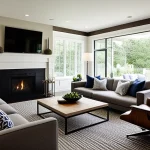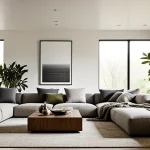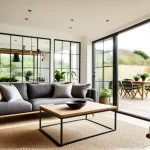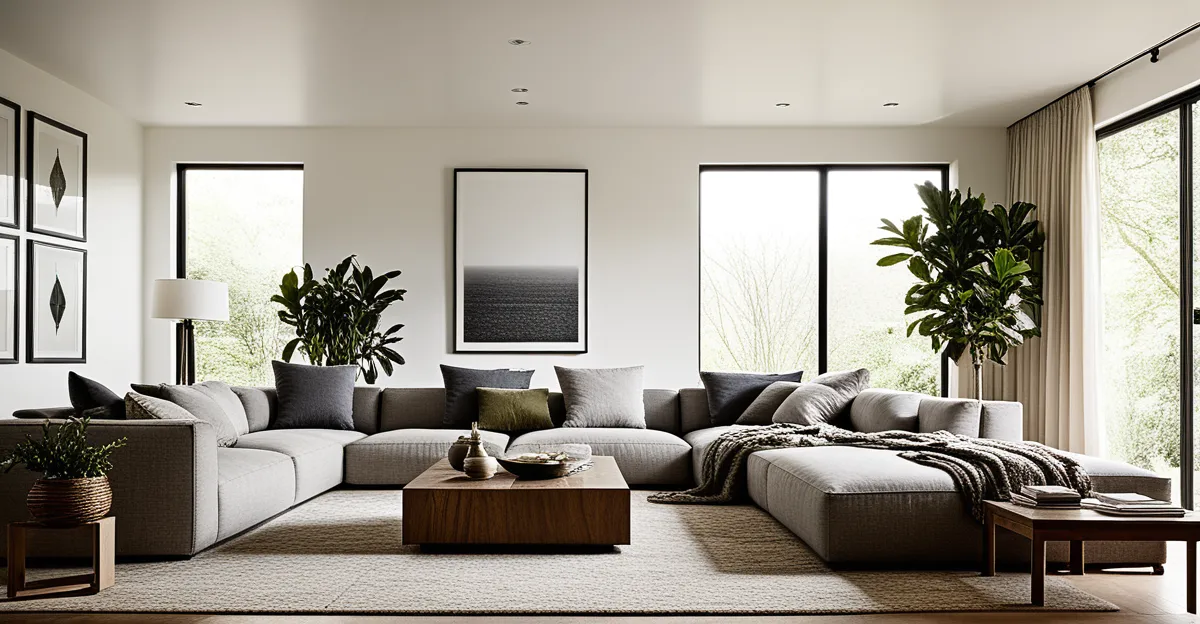Essential Steps to Create a Calming Living Room Atmosphere
Creating a living room sanctuary starts with decluttering and simplifying the space. Removing excess items clears visual distractions, allowing the mind to relax. A clutter-free room fosters calmness and makes it easier to maintain a peaceful environment.
Next, select a calming home decor palette. Soft, muted colors such as pale blues, gentle greens, or warm neutrals calm the senses and create a smooth flow throughout the room. Using these hues on walls and furnishings sets the foundation for a peaceful living room design.
This might interest you : Why Choose Sustainable Decor Trends for Your UK Home?
Incorporating nature-inspired elements is the final critical step. Adding houseplants or small water features introduces natural textures and soothing sounds, which enhance relaxation. These elements promote a connection to the outdoors and balance the room’s atmosphere, reinforcing the living room sanctuary concept.
Together, these steps form a seamless approach to transforming any living room into a calming refuge that nurtures well-being and comfort.
Topic to read : How Does Home Décor Transform Your Living Space into a Sanctuary?
Choosing and Arranging Furniture for Relaxation
Creating a living room sanctuary begins with selecting and arranging furniture that promotes calm and ease. Comfortable seating, such as plush sofas or ergonomic armchairs, is essential in a cozy living room setup. These pieces support relaxation by reducing physical stress, making them vital in a peaceful living room design.
How should furniture be arranged for maximum relaxation? Arrange seats in a way that encourages easy conversation and movement. Position sofas and chairs facing each other or around a central coffee table, fostering connection while leaving adequate space for smooth traffic flow. This approach balances social interaction with a soothing ambiance.
Why is ergonomic furniture important in a calming home decor? Ergonomic living room furniture reduces strain during extended relaxation, supporting posture and overall well-being. Choosing adjustable or properly cushioned pieces enhances physical comfort, reinforcing the room’s tranquil purpose.
Incorporate side tables and soft ottomans to add functionality without overcrowding the space. Thoughtful layout and ergonomics together transform the living room into a true living room sanctuary that invites rest and meaningful moments.
Lighting Your Living Room for Tranquility
Lighting plays a crucial role in crafting a living room sanctuary. To develop a calming ambiance, layered lighting is essential. Combine ambient lighting with table lamps, floor lamps, and candles to create depth and flexibility in the space. Why use multiple light sources? This approach allows for adjusting brightness levels depending on the mood or activity, enhancing a peaceful living room design.
Maximizing natural light is another important step in achieving calming home decor. Use soft, sheer curtains or blinds that let sunlight gently diffuse into the room. Natural light not only brightens but also lifts the spirit, making the living room more inviting during the day.
When selecting bulbs, opt for warm, soft tones rather than harsh white or blue light. These hues create a cozy atmosphere ideal for evenings, promoting relaxation and comfort. Integrating dimmers into your setup offers control over intensity, supporting varied uses from lively gatherings to quiet reading sessions. Thoughtful lighting choices significantly reinforce the relaxing environment of a living room sanctuary.
Enhancing Comfort with Textures and Accessories
To deepen the sense of calm in your living room sanctuary, introduce soft textiles like plush blankets, cushioned pillows, and thick rugs. These tactile elements provide warmth and invite you to relax physically, essential for a truly cozy living room setup. Textures engage the senses, making the environment feel nurturing and soothing.
Adding accessories such as calming decor pieces—think natural-inspired art, reflective mirrors, or subtle sculptures—can elevate the room’s ambiance. These accents contribute to the peaceful living room design by creating focal points that draw the eye without cluttering the space.
Layering different textures creates visual depth and interest. For example, pairing a woven throw with a velvet cushion or a jute rug under a soft carpet balances rough and smooth surfaces, adding complexity and comfort. This blending enhances the calming home decor theme by making the room feel inviting yet refined.
Ultimately, thoughtful choice of textured living room accessories enriches both look and feel, turning your space into a serene retreat that nurtures relaxation and well-being.
Expert Tips for a Serene Space
Creating a genuine living room sanctuary benefits from expert insights on design and function. Interior designers emphasize the importance of balance between aesthetics and comfort in cultivating a tranquil atmosphere. What key advice do experts give? They recommend prioritizing a relaxing furniture arrangement that supports rest while encouraging social connection, combined with ergonomic living room furniture to reduce physical strain.
Experts also highlight selecting calming color palettes and layering lighting to adjust moods effectively, reinforcing calming home decor principles. Incorporating natural elements like plants or simple water features is a recommended method to bridge indoor and outdoor serenity.
Common mistakes to avoid include overcrowding the space with too many accessories or neglecting proper lighting, which can disrupt the peaceful flow and lessen the sanctuary’s impact.
Top advice includes choosing multifunctional furniture and investing in quality textures, which enhance comfort without clutter. Applying these interior design tips supports a purposeful, serene living room where relaxation becomes effortless and the ambiance refreshes daily living.
Visual Inspiration: Before-and-After Transformations
Witnessing a living room makeover inspiration through visual comparisons can vividly demonstrate the power of design changes. For example, transforming a cluttered, dimly lit room into a relaxing room example often involves removing excess decor, selecting a calming color palette, and introducing layered lighting. These adjustments shift the mood from chaotic to serene, embodying a genuine living room sanctuary.
Key changes that contribute to a successful design transformation idea typically include: strategic furniture rearrangement to enhance flow, adding soft textiles to soften the space, and incorporating nature-inspired elements like plants. These improvements not only elevate aesthetics but also amplify comfort and tranquility.
Before images often reveal cramped layouts and harsh lighting, while after photos showcase airy, inviting spaces with warm, ambient lighting. Such visual case studies provide concrete evidence of how thoughtful adjustments aligned with calming home decor principles can rejuvenate a living room into a peaceful refuge.
Including photos or descriptions of these transformations can inspire readers to imagine their own spaces evolving into harmonious retreats, reinforcing the practical value of a well-executed peaceful living room design.





